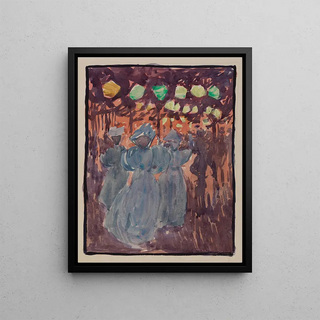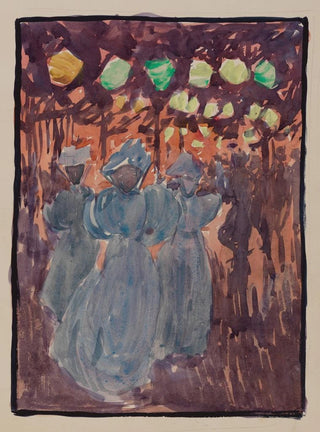Art print | Night scene with three women in blue - Maurice Prendergast


View from behind

Frame (optional)
In the rich and vibrant world of Impressionist art, the artwork "Night Scene with Three Women in Blue" by Maurice Prendergast stands out for its ability to capture the fleeting essence of a moment. This nocturnal scene, where darkness blends with flashes of light, invites the viewer to immerse themselves in a world of mystery and poetry. The three women, draped in dresses of blue shades, seem to dance to the rhythm of an invisible melody, evoking an atmosphere that is both intimate and universal. Prendergast, a master of color, manages to transform a simple scene into a sensory experience that transcends time and space.
Style and uniqueness of the artwork
Maurice Prendergast's style is characterized by bold use of color and a unique approach to composition. In "Night Scene with Three Women in Blue," the shades of blue, ranging from the darkest to the most vibrant, create a visual harmony that immediately draws the eye. The light, subtly depicted, appears to emanate from the characters themselves, illuminating their faces and movements with an almost ethereal delicacy. Prendergast employs broad, fluid brushstrokes, adding a dynamic dimension to the scene, as if the women are coming to life before our eyes. This treatment of color and light gives the artwork a dreamlike atmosphere, where the viewer is invited to engage emotionally and to feel the emotions of the characters.
The artist and his influence
Maurice Prendergast, born in 1858 in Saint-Étienne, is an iconic figure of American Impressionism. Influenced by European masters, he developed a style that is uniquely his own, blending elements of traditional Impressionism with modern sensibility. His fascination with urban life and leisure scenes, often populated by female figures, is reflected in many works. Prendergast also played a key role in introducing Impressionist art to America, inspiring a generation of artists to explore color and light in innovative ways. His work has been widely exhibited and recognized.

Matte finish

View from behind

Frame (optional)
In the rich and vibrant world of Impressionist art, the artwork "Night Scene with Three Women in Blue" by Maurice Prendergast stands out for its ability to capture the fleeting essence of a moment. This nocturnal scene, where darkness blends with flashes of light, invites the viewer to immerse themselves in a world of mystery and poetry. The three women, draped in dresses of blue shades, seem to dance to the rhythm of an invisible melody, evoking an atmosphere that is both intimate and universal. Prendergast, a master of color, manages to transform a simple scene into a sensory experience that transcends time and space.
Style and uniqueness of the artwork
Maurice Prendergast's style is characterized by bold use of color and a unique approach to composition. In "Night Scene with Three Women in Blue," the shades of blue, ranging from the darkest to the most vibrant, create a visual harmony that immediately draws the eye. The light, subtly depicted, appears to emanate from the characters themselves, illuminating their faces and movements with an almost ethereal delicacy. Prendergast employs broad, fluid brushstrokes, adding a dynamic dimension to the scene, as if the women are coming to life before our eyes. This treatment of color and light gives the artwork a dreamlike atmosphere, where the viewer is invited to engage emotionally and to feel the emotions of the characters.
The artist and his influence
Maurice Prendergast, born in 1858 in Saint-Étienne, is an iconic figure of American Impressionism. Influenced by European masters, he developed a style that is uniquely his own, blending elements of traditional Impressionism with modern sensibility. His fascination with urban life and leisure scenes, often populated by female figures, is reflected in many works. Prendergast also played a key role in introducing Impressionist art to America, inspiring a generation of artists to explore color and light in innovative ways. His work has been widely exhibited and recognized.






